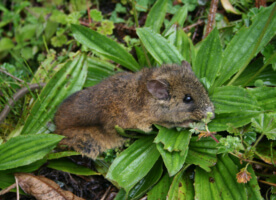
Dr. Tom Lee, Clark Stevens Professor of Biology at Abilene Christian University, discovered a new rat species, Thomasomys burneoi, 2,500 meters above sea level in the Andes Mountains of Ecuador, and news of the discovery has recently been published in a scientific journal.
Thomasomys burneoi is a large rat species in the rich Andes Mountain environment. The species is the 48th under the genus Thomasomys and the 18th such species found in Ecuador. Lee first found the species in Sangay National Park in Zunac, Ecuador, in 2010.
Lee’s discovery and research about Thomasomys burneoi was published this year after several years of uncertainty about whether the specimen represented a new species. Three years ago, Lee received a clue that the species might be new, and he compared the specimen with others in museum collections to determine the rarity of the animal. Once comparisons were made, Lee wrote an article about the specimen in a peer-reviewed journal that was accepted by the mammalogy scientific community this year.
“I encountered these species a pretty long time ago, but because this is a new species, it was very difficult to nail down what it was,” Lee said. “We find these things in Ecuador and initially my mindset was, ‘Oh no, we’ve seen this before.’ But in Ecuador, there’s so many new species being described that you have to have that possibility in your brain every time you identify something.”
Thomasomys burneoi is named after one of Lee’s colleagues, Santiago Burneo, a professor and researcher at Pontificia Universidad Católica del Ecuador in Quito, Ecuador, who helped him discover the rat. Burneo and Lee met when Lee was looking for a place to research mammals, and since then, the two have worked together on numerous projects.
“To have it named after me was a really great surprise,” Burneo said. “This motivates me to keep doing the work we do and to keep researching and doing conservation activities for the mammals.”

The discovery of Thomasomys burneoi was published in Vertebrate Zoology, a scientific journal focusing on research in the areas of taxonomy, morphology, anatomy, phylogeny, historical biogeography, and paleontology of vertebrates. In addition, news of the new species found its way into the Straits Times, a Singapore newspaper.
“This speaks to the fact that we’re doing research at a really high level,” Lee said.
Lee has been a professor of biology at ACU for 28 years and is the lone mammalogist in the department. He also holds the Dr. Clark Stevens Endowed Professorship position. Lee has taken numerous trips to Ecuador, primarily in the Andes Mountains, and discovered four species, including Tanyuromys thomasleei, a long-tailed montane rat that friends named after him in 2018 to honor his contributions to mammalogy.
Another of Lee’s colleagues, Dr. Bob Dowler, has worked closely with Lee in his research in Ecuador. Dowler was a professor of biology at Angelo State for 34 years and recently retired this past summer. He started traveling to the Galapagos Islands in 1995 and, in 2000, invited Lee to join him.
“There was not a lot known about the rodents that were there,” Dowler said. “Lee and I were colleagues, and he started his research efforts from that point on.”
Lee’s research is aided by and provides unique research opportunities for undergraduate students in ACU’s Department of Biology.
“All those trips to Ecuador, there’s always students involved. There has never been a trip where I just went down there by myself,” Lee said.
Learn more about the Department of Biology.
— Connor Mullins
Oct. 25, 2022
